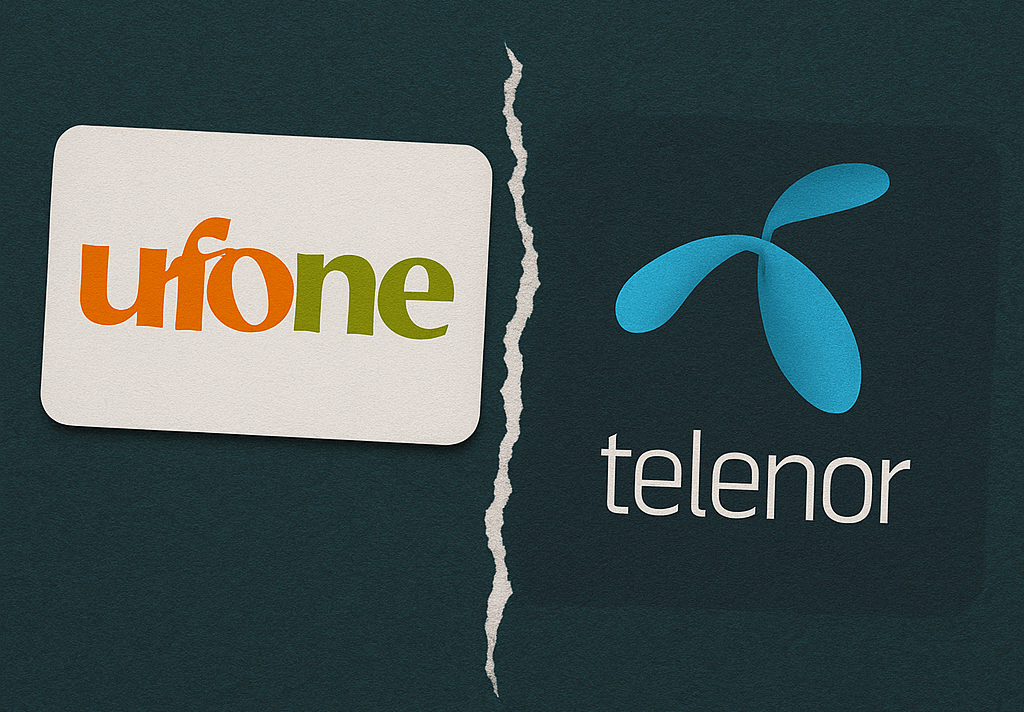
Aftab Maken
In the bustling world of Pakistani telecommunications, a big story was brewing. Pakistan Telecommunication Company Limited, or PTCL as everyone knew it, had a mobile company under its wing called Ufone. Think of PTCL as a big, older brother and Ufone as the younger sibling, full of energy but also finding it a bit tricky to make its own way financially.
For a long time, Ufone hadn’t been making profits. In fact, it had been losing quite a bit of money, billions to be exact. Like a concerned older brother, PTCL had been helping out, covering Ufone’s costs from its own earnings. This is something called cross-subsidization – when one part of a business helps another part stay afloat.
Now, PTCL had its eyes on a new venture. It was planning to join forces with another big telecom player in the country, Telenor Pakistan. A merger, they called it – a way for both companies to come together and become even stronger, offering better services to their customers. It was an exciting prospect, like two popular neighborhood cricket teams deciding to merge to form a super-team.
However, there was a significant wrinkle in this grand plan: Ufone’s financial troubles. The news of Ufone’s losses wasn’t just quiet office gossip; it was a serious concern, especially for the government, which plays the role of a referee in such big business deals to ensure everything is fair and transparent.
Imagine a group of wise elders in a village (the government) who have to approve a major partnership. Before they give their blessing, they want to look at all the details very carefully. In this case, the elders declared, “Hold on a minute! Before we say ‘yes’ to this PTCL and Telenor merger, we need to take a really close look at Ufone’s account books.”
This was a major hurdle. It was like wanting to build a magnificent new bridge (the merger) but first having to make sure that an existing, slightly shaky part of the foundation (Ufone) was strong enough or, at least, that everyone fully understood its condition.
Industry sources, people who have a good ear to the ground in the telecom world, whispered about how PTCL had been patiently supporting Ufone. But patience and support from a parent company can only go so far when such a massive new deal is on the table. The government’s insistence on scrutinizing Ufone’s financials meant that all of Ufone’s past financial struggles were now under a very bright spotlight.
The dream of PTCL and Telenor coming together was a big one, promising a new era for mobile users. But Ufone’s balance sheets, filled with more expenses than income, had become a central point of discussion and worry. The path to the merger was suddenly not as smooth as initially hoped. It was a reminder that in the world of big business, every part of the family, even a struggling one like Ufone, plays a crucial role, and their challenges can cast a long shadow on even the most ambitious plans.
The fate of the merger, it seemed, was now closely tied to how these financial concerns around Ufone would be addressed to the satisfaction of the watchful eyes of the government. In the bustling world of Pakistani telecommunications, a giant named PTCL had big dreams. It wanted to join forces with another major player, Telenor, in a merger that promised to reshape the industry, creating a powerhouse of connectivity. It was a bold vision, one that could bring better services and wider reach to millions. But like any grand plan, this one had a significant hurdle, a nagging worry that kept everyone on edge: Ufone.
Ufone was PTCL’s own mobile service provider, a subsidiary that, despite its familiar name, was struggling. For a long time, it felt like PTCL, the parent company, was quietly propping up Ufone, channeling funds to keep it afloat. Think of it like a family where one sibling is constantly helping out another who can’t seem to get their finances straight. Industry whispers called it “cross-subsidization.” While PTCL maintained that Ufone was its own distinct company making its own way, the numbers told a worrying tale of consistent losses. These weren’t just small setbacks; they were “billions in losses,” a heavy anchor dragging on PTCL Group’s overall performance, even when other parts of the business were doing well.
As PTCL and Telenor moved closer to their ambitious merger, the government, a major shareholder in PTCL, decided it was time to take a much closer look. Imagine a stern but fair elder in the family stepping in before a big commitment, saying, “Hold on, let’s make sure everything is in order here.” The officials, along with the Competition Commission of Pakistan (CCP), the country’s anti-trust watchdog, wanted to peek under Ufone’s financial hood. They needed to understand why Ufone was bleeding money and what that might mean for the bigger picture if PTCL and Telenor were to become one.
The scrutiny wasn’t just a formality. Ufone’s financial statements were complex, and the CCP was determined to unravel the reasons for the losses. Was it mismanagement? Tough market conditions? Or something else entirely? The IT Minister acknowledged the problem, noting that while Etisalat, PTCL’s major partner, had management control, the government, as an owner, couldn’t ignore the persistent red ink.
This deep dive into Ufone’s books became a major roadblock for the merger. PTCL’s leadership grew anxious. They had lined up significant financing, including a crucial loan from the International Finance Corporation (IFC), to make the Telenor acquisition happen. But these financial agreements often have timelines, and the delays in getting the green light from the CCP were putting this funding at risk. The dream of a bigger, stronger PTCL-Telenor entity felt like it was stuck in quicksand, with Ufone’s financial woes at the center of the mire.
Other telecom companies, watching from the sidelines, also raised concerns. They worried that if PTCL, already a giant, merged with Telenor, it could create a monopoly, making it harder for anyone else to compete. It was like smaller shops worrying about a new mega-mall opening in town.
So, the grand merger, a vision of a new telecom titan, found itself caught in a complex web. At its heart was Ufone, the struggling subsidiary whose billions in losses were more than just an accounting problem. They were a critical test of transparency, a challenge for regulators, and a potential deal-breaker for one of the biggest corporate moves in Pakistan’s recent history. The path to the merger was no longer a straight highway but a winding road with a very large, Ufone-shaped obstacle in the middle, and everyone was waiting to see if, and how, it could be cleared.
 BeNewz
BeNewz




